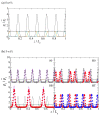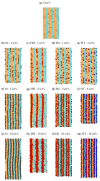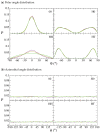Molecular Dynamics of Janus Nanodimers Dispersed in Lamellar Phases of a Block Copolymer
- PMID: 34065148
- PMCID: PMC8126030
- DOI: 10.3390/polym13091524
Molecular Dynamics of Janus Nanodimers Dispersed in Lamellar Phases of a Block Copolymer
Abstract
We investigate structural and dynamical properties of Janus nanodimers (NDs) dispersed in lamellar phases of a diblock copolymer. By performing molecular dynamics simulations, we show that an accurate tuning of the interactions between NDs and copolymer blocks can lead to a close control of NDs' space distribution and orientation. In particular, NDs are preferentially found within the lamellae if enthalpy-driven forces offset their entropic counterpart. By contrast, when enthalpy-driven forces are not significant, the distribution of NDs, preferentially observed within the inter-lamellar spacing, is mostly driven by excluded-volume effects. Not only does the degree of affinity between host and guest species drive the NDs' distribution in the polymer matrix, but it also determines their space orientation. In turn, these key structural properties influence the long-time dynamics and the ability of NDs to diffuse through the polymer matrix.
Keywords: coarse-grained; copolymer; diffusion; janus; lamellar; molecular dynamics; nanoparticles; nematic; orientational order; polymer nanocomposites.
Conflict of interest statement
The authors declare no conflict of interest. The funders had no role in the design of the study; in the collection, analyses, or interpretation of data; in the writing of the manuscript, or in the decision to publish the results.
Figures










Similar articles
-
Ordering of anisotropic nanoparticles in diblock copolymer lamellae: Simulations with dissipative particle dynamics and a molecular theory.J Chem Phys. 2017 Apr 14;146(14):144902. doi: 10.1063/1.4979897. J Chem Phys. 2017. PMID: 28411620
-
Molecular simulation of hybrid polymer nanocomposites with organic nanodimers and inorganic nanorods: From structure and dynamics to viscosity.J Chem Phys. 2025 May 7;162(17):174906. doi: 10.1063/5.0255157. J Chem Phys. 2025. PMID: 40322994
-
Coarse-grained molecular dynamics simulation on the placement of nanoparticles within symmetric diblock copolymers under shear flow.J Chem Phys. 2008 Apr 28;128(16):164909. doi: 10.1063/1.2911690. J Chem Phys. 2008. PMID: 18447502
-
Alignment of lamellar diblock copolymer phases under shear: insight from dissipative particle dynamics simulations.Langmuir. 2007 Apr 24;23(9):4809-18. doi: 10.1021/la063095c. Epub 2007 Mar 22. Langmuir. 2007. PMID: 17375943
-
Stability and orientation of lamellae in diblock copolymer films.J Chem Phys. 2013 Aug 7;139(5):054908. doi: 10.1063/1.4815919. J Chem Phys. 2013. PMID: 23927285
Cited by
-
Hybrid Time-Dependent Ginzburg-Landau Simulations of Block Copolymer Nanocomposites: Nanoparticle Anisotropy.Polymers (Basel). 2022 May 7;14(9):1910. doi: 10.3390/polym14091910. Polymers (Basel). 2022. PMID: 35567080 Free PMC article. Review.
-
Performance Test of Micro-Slit Antenna Loaded with High Refractive Index Medium Based on Image Recognition.Comput Intell Neurosci. 2022 Sep 22;2022:9967681. doi: 10.1155/2022/9967681. eCollection 2022. Comput Intell Neurosci. 2022. PMID: 36188709 Free PMC article.
References
-
- Yang Q., Loos K. Janus nanoparticles inside polymeric materials: Interfacial arrangement toward functional hybrid materials. Polym. Chem. 2017;8:641–654. doi: 10.1039/C6PY01795A. - DOI
-
- Puglia D., Kenny J. Chapter 7—Structure-property relationships of thermoset nanocomposites. In: Guo Q., editor. Thermosets. 2nd ed. Elsevier; Amsterdam, The Netherlands: 2018. pp. 231–276. - DOI
-
- Müller K., Bugnicourt E., Latorre M., Jorda M., Echegoyen Sanz Y., Lagaron J.M., Miesbauer O., Bianchin A., Hankin S., Bölz U., et al. Review on the Processing and Properties of Polymer Nanocomposites and Nanocoatings and Their Applications in the Packaging, Automotive and Solar Energy Fields. Nanomaterials. 2017;7:74. doi: 10.3390/nano7040074. - DOI - PMC - PubMed
-
- Hernández-Muñoz P., Cerisuelo J.P., Domínguez I., López-Carballo G., Catalá R., Gavara R. Chapter 8—Nanotechnology in Food Packaging. In: López Rubio A., Fabra Rovira M.J., Martínez Sanz M., Gómez-Mascaraque L.G., editors. Nanomaterials for Food Applications. Elsevier; Amsterdam, The Netherlands: 2019. pp. 205–232. Micro and Nano Technologies. - DOI
Grants and funding
LinkOut - more resources
Full Text Sources

